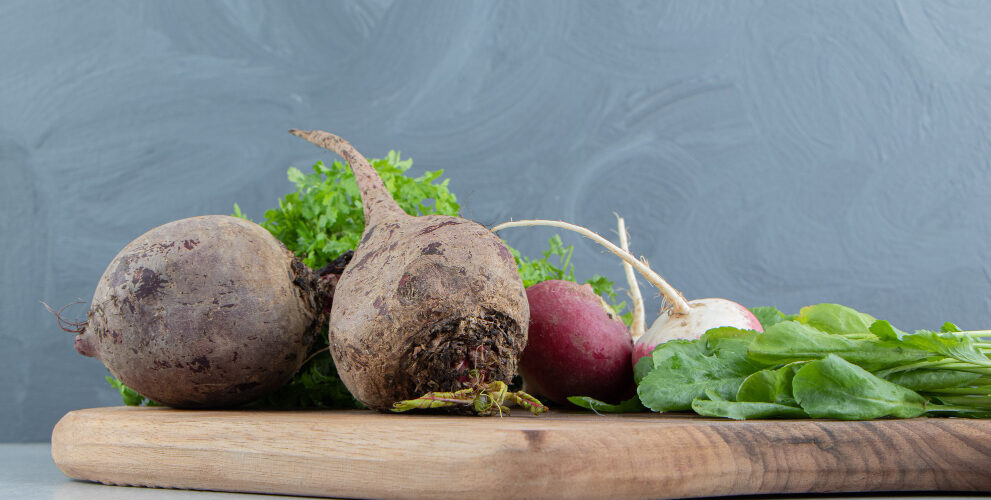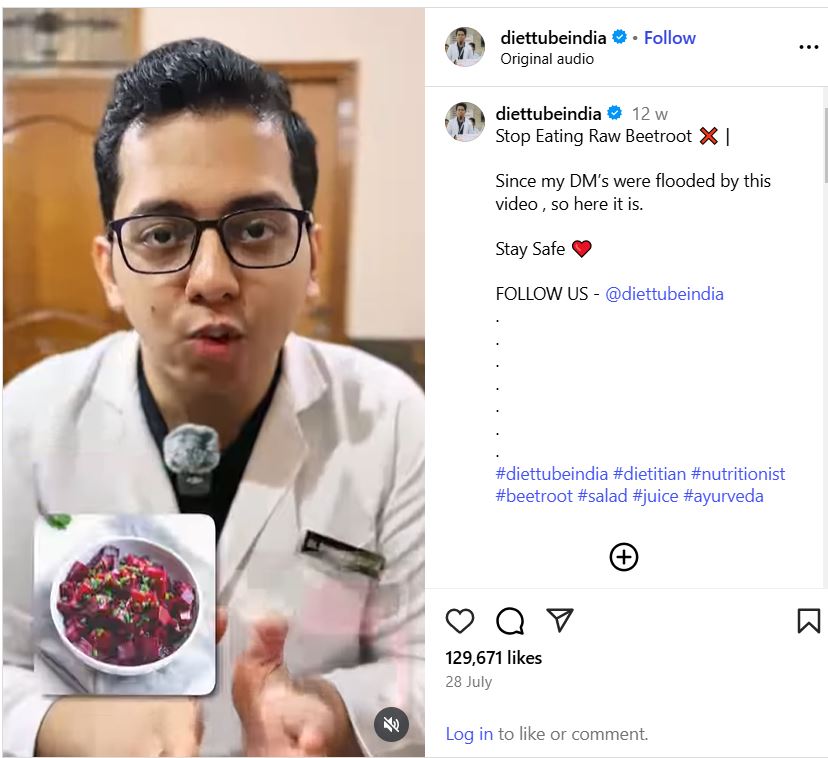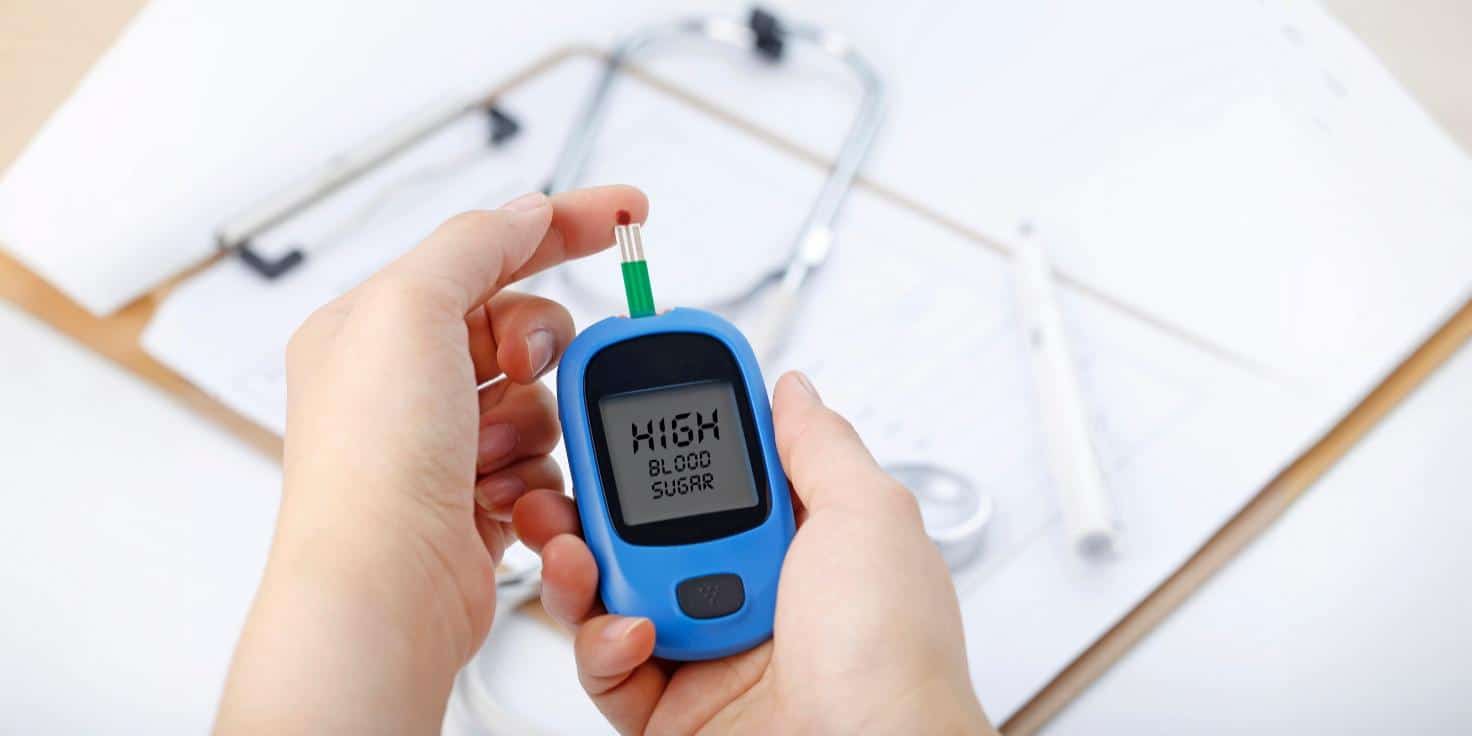Latest
FACT CHECK: Should we stop eating beetroot?
Beetroot has earned its place as a modern-day “superfood,” celebrated for both its nutritional richness and culinary versatility. But is there a right and wrong way to consume it?
Author
Author
- admin / 2 days

- 0
- 7 min read

Author
Eating raw beetroot in the form of salads or juice is harmful to health and should be avoided.
FACT:
Beetroot is safe and nutritious, but raw forms may carry microbes, oxalates, or heavy metals if grown in polluted soil. Experts recommend washing, peeling, and boiling/parboiling instead of completely avoiding it.
An Instagram reel by dietician Bhawesh Gupta has sparked heated debate online over whether eating beetroot—often promoted as a superfood—could actually harm your health.
Gupta warns viewers to stop consuming raw beetroot in the form of salads or juices, claiming it may contain dangerous microbes, heavy metals, and antinutrients that could damage vital organs and increase the risk of kidney stones.
“If you consume beetroot in the form of salad or juice in the name of health, then stop doing it today itself,” says Gupta. He goes on to explain that in recent times, many of his followers had shared a video with him where someone is telling people not to eat beetroot, as it is very dangerous.
Should we stop eating beetroot?
Beetroot has earned its place as a modern-day “superfood,” celebrated for both its nutritional richness and culinary versatility. According tothe database displays in the US Department of Agriculture Agricultural Research Service, beetroot is “not only rich in proteins (1.68 g), carbohydrates (9.96 g), fat (0.18 g), amino acids (1.216 g), fatty acids (0.119 g), phytosterols (0.025 g), minerals (0.483 g), and fibers (2 g) per 100 g of wet weight, but also contains a lot of biologically active phytonutrients.”

Meanwhile, research also points to certain risks associated with beetroot consumption, particularly when consumed raw or in excess. For example, a review on beetroot juice (BRJ) notes: “Aside from the beneficial aspects of BRJ (Beetroot juice) consumption, there may also be potential health risks.
Drinking BRJ may easily increase nitrate intake above the acceptable daily intake, which is known to stimulate the endogenous formation of N-nitroso compounds (NOCs), a class of compounds that is known to be carcinogenic and that may also induce several other adverse effects. Compared to studies on the beneficial effects, the amount of data and literature on the negative effects of BRJ is rather limited, and should be increased in order to perform a balanced risk assessment.”
Beetroot also contains oxalates, compounds with antinutrient properties that can interfere with calcium absorption and increase the risk of kidney stones. While oxalates are especially concentrated in beet greens, the root itself is also considered high in oxalates. A review highlighted that “dietary oxalate may be important in stone development; spinach, beets and rhubarb in particular, contain large amounts of oxalate and they may increase urinary oxalate excretion and predispose to the development of calcium oxalate stones.”
Another concern is related to gut health. Beetroot is classified as a high FODMAP food due to its fructan content. For sensitive individuals, especially those with irritable bowel syndrome (IBS), this can cause bloating, gas, and digestive discomfort.
In fact, there have also been rare reports of foodborne outbreaks linked to raw beetroot. A study in Finland reviewed seven such outbreaks in 2010, where “consumption of raw beetroot was strongly associated with gastrointestinal illness (relative risk 8.99, 95% CI 6.06–13.35).”
The illness typically had a rapid onset of gastrointestinal symptoms within 40 minutes and lasted around five hours. Though no common pathogens were detected, “all tested beetroot samples were of poor quality according to total bacterial counts,” and beta-haemolytic Pseudomonas fluorescens was found in several samples. Following this, Finland’s Food Safety Authority advised against serving raw beetroot in institutional canteens, after which no further outbreaks were reported.
Supporting these safety concerns, another body of research shows that beetroot has the tendency to accumulate heavy metals depending on soil conditions and the cultivar. A study from Poland on 15 red beet cultivars found that “beetroot does accumulate heavy metals such as cadmium (Cd) and chromium (Cr),” although some varieties like ‘Opolski’ and cylindrical-root cultivars showed lower accumulation.
Similarly, research from Ethiopia revealed that beetroot grown in industrially impacted soils using wastewater had elevated levels of metals, with cadmium levels around “0.96 mg/kg, which was higher than FAO/WHO limits.”
Rajeshwari Panda, Head of the Dietetics Department at Medicover Hospital, Kharghar, Navi Mumbai, says it is not necessary to completely avoid beetroot, but how we consume it matters.
“When we talk about raw beetroot or any vegetables, it’s very simple — you have to wash them very well. Parboiling or cooking helps kill viruses and bacteria. Washing thoroughly and peeling are the biggest factors for safety,” she explained. For vulnerable groups such as pregnant women or those with weak immunity, she advises preferring boiled beetroot, as “boiling also kills a lot of bacteria.”
On the concern about pesticides and heavy metals, Panda noted that since beetroot is a root vegetable, it can absorb harmful substances from polluted soils. However, she added, “Not all beetroot can be toxic. Buying local, seasonal, or organic produce can help reduce this risk.”
Addressing the claim that beetroot’s oxalate content increases kidney stone risk, Panda clarified that this is often overstated. She pointed out that oxalates are naturally present in many foods such as spinach, almonds, and even tea. “For mostly healthy people, eating raw beetroot in moderation does not cause kidney stones. Other factors like low water intake, high sodium, excess animal protein, and genetics are equally important. Hydration is far more crucial than simply avoiding oxalate-rich foods.”
On digestive issues in people with IBS and IBD, Panda acknowledged that raw vegetables, including beetroot, can sometimes trigger symptoms. “It’s not just beetroot — most raw veggies can cause problems for IBS patients. Boiling well and chewing properly helps. Instead of eliminating beetroot altogether, it should be reintroduced slowly under supervision once the gut is repaired with probiotics and fiber.”
She also addressed the widespread belief that beetroot is rich in iron. “It’s since generations that we’ve been hearing beetroot is high in iron — that’s not the case. It actually contains less iron than many other foods. Plus, just taking iron is not enough. For proper absorption, vitamin C is equally important.” She recommended pairing iron-rich foods with vitamin C sources like lemon, amla, guava, and oranges.
Panda stressed the importance of variety over consuming the same food daily. “Beetroot every day is not recommended. Having it in small portions in salads or subzis is fine, but everyday consumption is not beneficial. Variation is the key.” She added that people with diabetes or those managing weight should also watch the portion size because beetroot is a root vegetable.
As for the best way to consume beetroot, she advised: “We don’t recommend raw juices. Chewing vegetables is better. If you want to make juice, parboil the beetroot first. That kills toxins and makes it safer. Boiled or parboiled beetroot is the best option today, given we don’t always know where it’s coming from or what pesticides have been used.”
Also read: FACT CHECK: Should you stop drinking vegetable juice?
(Do you have a health-related claim that you would like us to fact-check? Send it to us, and we will fact-check it for you! You can send it on WhatsApp at +91-9311223141, mail us at hello@firstcheck.in, or click here to submit it online)










